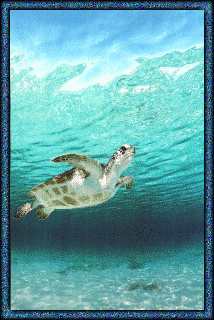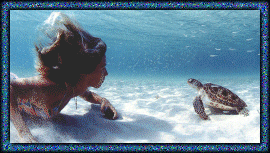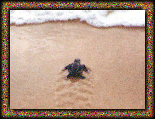 
Sea turtles are found off every continent except Antarctica. They have adapted well to life in the water with their flat, streamlined shells that help them move easily through the water. Their flippers help the turtle maneuver as they feed and avoid predators. The sea turtle's biggest predator is man. They are killed for meat, leather, jewelry, and their eggs are taken for food. Nesting sites go for development. They are poisoned by pollution as well as die by drowning in nets and fishline. There have been efforts to help. In 1973, the Convention on International Trade in Endangered Species (CITES) was signed by many countries. This made it illegal to bring a sea turtle or anything made from it into the United States. Also the law to make Turtle Excluder Devices (TEDS) manditory on shrimp boats have helped.
Biologists speculate that the sea turtle takes from 10 to 50 years to mature and reproduce. Most females come ashore every 2 to 3 years to nest. Males spend their whole lives in the sea. Turtles mate in the sea. After the eggs have formed the females come to shore to lay their eggs where they were hatched themselves. It takes the female many hours to dig her nest and lay the eggs. She lays 50 to 100 ping-pong ball sized eggs. After about 60 days the young turtles begin to hatch and hopefully head to sea. Very few even survive this far, much less the open ocean. They have a less than 1% chance of survival to maturity. 
There are 8 species of sea turtles:The Olive Ridley (Lepidochelys olivacea) is the most abundant and one of the smallest at a length of 30 inches or less. They are found in the tropics of the Pacific, Atlantic, and Indian Oceans. The Kemp's Ridley (Lepidochelys kempii) is the most endangered species of marine turtles, and it has been decimated by egg harvesting. They are up to 30 inches in length. They swim in the shallows of the Gulf of Mexico and the North American Atlantic Ocean. The Leatherback (Dermochelys coriacea) has a slightly flexible carapace (the shell). They are up to 74 inches in length. They make the longest seasonal migration. They are adapted to the Arctic waters as well as tropical waters. The Loggerhead (Caretta caretta) is the most commonly found turtle. They are up to 47 inches in length. They feed in subtropic estuaries and along the continental shelf. 
The Hawksbill (Eretmochelys imbricata) swims in coral reefs and is up to 35 inches in length. The Green (Chelonia mydas) is a gentle vegetarian. It is up to 49 inches in length and grazes on sea grasses in the tropics. The Black seaturtle (Chelonia agassizi) is perhaps a subspecies of the Green turtle. It is up to 39 inches in length and is found in the eastern Pacific ocean from Baja California to the Galapagos Islands. The Austrialian Flatback (Natator depressus) is not found in the Western Hempishere. It is up to 39 inches in length. Sea turtles can suffer grievous injuries, but some are lucky enough to be found and taken to Sea Turle Centers to be seen by Veterinaians. Such as the Georgia Sea Turle Center on Jekyll Island in Georgia. Injuries are usually caused by boats and their propellers. The Georgia Sea Turtle Center has been using new treatments that are based on ancient Roman medicine. They use a milky, sticky paste made from beeswax and is generously coated with honey that is plugged into the deep wounds of sea turtles. The honey seems to help kill the bacteria that causes infections as well as boosting the immune system. The beeswax keeps out water that fungus needs to grow. Honey was onced used in healing sores and cuts for humans, but fell by the wayside when antibiotics were introduced in the 1940s. In 1999, sea turtles had a near record nesting year at Cape Hatteras National Seashore (North Carolina, USA), but the bad news is that hurricanes destroyed or disturbed more than half their nests. Only a third of the laid eggs hatched. Confirmed were 92 nests on the barrier islands and about 1,100 nests reported statewide. Of the 92 nests, 40 hatched before Hurricanes Dennis and Floyd, and 27 of the remaining 52 nests were washed away in those storms. Hatchlings were reported at just one of the 25 nests that survived. Similar nesting losses were reported up and down the coast after Hurricane Dennis. Loggerheads are the state's primary nesting species. Natural occurances like this will always happen, which is why it is so important to protect their nesting grounds so that they may recover from unpreventable natural disasters. Update through the 2008 season: For the state of Georgia, a record 1,646 nests were counted for loggerhead turtles along the states 100 mile coast line. 2008 was the 20th year that biologists and volunteers counted loggerhead nests along the coast of Georgia. This year's counts did exceed by 9% last years, though some nests were lost to Tropical Storm Fay in September of 2008. Female loggerheads lay eggs from May through August, and the eggs hatch into October. Researchers use nest counts as an indicator of overall health of the population, as loggerheads spend most of the year out at sea. For the state of South Carolina, 4,500 nests were counted as its best season since 1999. For the state of North Carolina, final numbers were not official, but at least 832 nests were counted. That was already above the state's average of 715 nests per year. All counts in all states reflect nests destroyed by Tropical Storms Fay and Hanna in August and September. So there were less hatchlings because of those destroyed nests. There were less dead loggerheads washed up onto Georgia beaches in 2008, which have been in part of fewer shrimp boats trawling in Georgia waters due to high fuel costs and low costs of market shrimp prices. 
References

Site Map Ocean Dreams Email at: dh @ naturehaven.com (Take out the spaces and this email address will work!) Please Read Guestbook ~~~ Please Sign Guestbook  |
 A TED is a small net or metal grid inside of the shrimper's sock-shaped nets that is supposed to allow shrimp to pass to the back while ejecting the turtles. Coastal development is also a big problem. The turtles like high rises. At night buildings are dark and look like a high row of trees. The higher the building, the more nests are found in front of the building. Later when there are hatchlings, the light leaking between buildings onto the beach can disorient them and they head inland instead of out to sea.
A TED is a small net or metal grid inside of the shrimper's sock-shaped nets that is supposed to allow shrimp to pass to the back while ejecting the turtles. Coastal development is also a big problem. The turtles like high rises. At night buildings are dark and look like a high row of trees. The higher the building, the more nests are found in front of the building. Later when there are hatchlings, the light leaking between buildings onto the beach can disorient them and they head inland instead of out to sea.